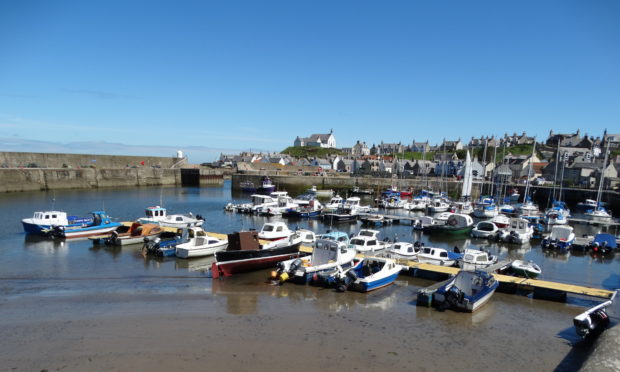The Doyenne and I are home after a short break on the Morayshire coast. It’s a part of Scotland we got to know when our son Robert and his family had a holiday cottage in the fishing village of Portknockie.
The fishing villages of the east coast of Scotland tell the story of the fishing industry’s importance to the development of the north-east. Between Berwick-on-Tweed and the Pentland Firth there are at least 135 towns and villages that owe their existence to fishing. Fishing’s importance to Scotland’s economy is still evident today from the political concerns being aired in the Brexit negotiations.
The Banff and Moray coast is known as the Riviera of the North. It lived up to its reputation for the few days we were there but the weather broke spectacularly on Saturday night. The first rumbles of thunder started about four o’clock and lasted well into the evening, and the rain varied from steady to torrential. But it cleared the air and we drove home on Sunday in bright sunshine.
I may have mentioned in the past that I have a passion for harbours and small boats. I can’t pass a finger post directing the casual traveller to Harbour or Pier without turning off to see what there is at the end of the road. It near drives the Doyenne demented but she kindly indulges me most of the time.
They speak the Buchan dialect up there. You need to become accustomed to the local pronunciation of some of the village names – Sinnen for Sandend, Finechty for Findochty, Gamrie for Gardenstown – to be sure you’re getting the right directions for where you want to go.
Ask for bannocks at the baker and you’ll be given large, plate-sized pancakes. Aberdeen butteries are roweys in Portsoy but in Portknockie, just eight miles along the coast, they are ‘rowleys’. Oatcakes are breid, so if you should find yourself getting flustered when you’re next in an Aberdeenshire bakery, maybe it’s easier just to point to what you want and say “I’ll take some of those”.
And they’re friendly up there. Folk take a moment to greet you and stop to pass the time of day. I’ve always found it pays to speak to people – they’ll tell you which is the best pub, the places of interest and where to buy the freshest fish. Mention where you come from and next thing you’re talking about mutual friends.
Peter Anson, in his classic book Fishing Boats and Fishing Folk on the East Coast of Scotland graphically describes the lives of the fisher folk a century ago, illustrating the text with fine pen and ink sketches of the different types of fishing craft and the gear they used.
But boats became larger, able to sail further to the fishing grounds, and the fishing fleets are now concentrated in the major fishing ports of Peterhead and Fraserburgh. The smaller harbours are no longer the full-time working places of the past. Most of them are home to small creel boats fishing for shell fish and the larger ones, such as Findochty and Whitehills, have been developed as small marinas.
Almost all were built with an outer harbour and an inner harbour to protect the boats from the ferocity of the winter seas that sometimes rage on that north-facing coast. The former lifeboat station at Whitehills has been converted to a house and storm doors have been built to protect the sea-facing windows from waves driven onto the shore which at their worst, the owner told us, can be higher than the height of the roof.
No village is more than about a dozen miles from the next and I was in my element driving from one to the next. The original villages grew up informally around their harbours, unrestricted by the bureaucracy of planning laws. Sandend, which has a lovely stretch of sandy beach, is very typical and many of the cottages sit gable-end onto the sea presenting least resistance to the winter gales, like boats riding out a storm.
A patch of melancholy thistles by the harbour side was alive with Painted Lady butterflies which are attracted to thistles, and daytime flying moths which I didn’t recognise. As we drove out of the village towards Cullen I spotted a raven sitting on a fence post preening itself and quite unconcerned at the attention I was giving it as I stopped the car. Not traditionally birds of the north-east, they are becoming a more common sight east of the Highland Line.
The agriculture in the great coastal plain is a mixture of beef and dairy and sheep, large grass fields with not a plastic polytunnel – so much an accepted part of our Mearns landscape – to be seen. And fields waving with ripening barley. It’s what you’d expect so close to the distilleries of the Spey valley which need the malted barley to start the sublime process of making malt whisky, Scotland’s blessed water of life.


